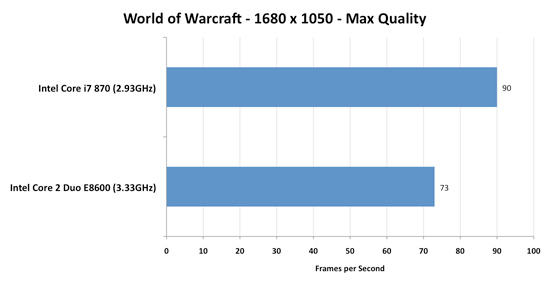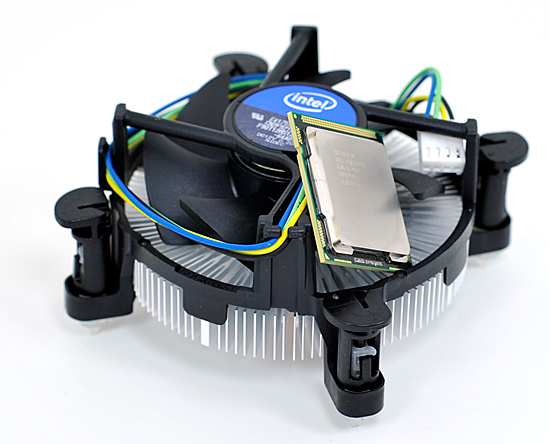Intel's Core i7 870 & i5 750, Lynnfield: Harder, Better, Faster Stronger
by Anand Lal Shimpi on September 8, 2009 12:00 AM EST- Posted in
- CPUs
Lynnfield's Turbo Mode: Up to 17% More Performance
Turbo on Bloomfield (the first Core i7) wasn't all that impressive. If you look back at our Core i7 article from last year you'll see that it's responsible for a 2 - 5% increase in performance depending on the application. All Bloomfield desktop CPUs had 130W TDPs, so each individual core had a bit more breathing room for how fast it could run. Lynnfield brings the TDP down around 27%, meaning each core gets less TDP to work with (the lower the TDP, the greater potential there is for turbo). That combined with almost a full year of improving yields on Nehalem means that Intel can be much more aggressive with Turbo on Lynnfield.
| SYSMark 2007: Overall | Dawn of War II | Sacred 2 | World of Warcraft | |
| Intel Core i7 870 Turbo Disabled | 206 | 74.3 fps | 84.8 fps | 60.6 fps |
| Intel Core i7 870 Turbo Enabled | 233 | 81.0 fps | 97.4 fps | 70.7 fps |
| % Increase from Turbo | 13.1% | 9.0% | 14.9% | 16.7% |
Turbo on Lynnfield can yield up to an extra 17% performance depending on the application. The biggest gains will be when running one or two threads as you can see from the table below:
| Max Speed | Stock | 4 Cores Active | 3 Cores Active | 2 Cores Active | 1 Core Active |
| Intel Core i7 870 | 2.93GHz | 3.20GHz | 3.20GHz | 3.46GHz | 3.60GHz |
| Intel Core i7 860 | 2.80GHz | 2.93GHz | 2.93GHz | 3.33GHz | 3.46GHz |
| Intel Core i5 750 | 2.66GHz | 2.80GHz | 2.80GHz | 3.20GHz | 3.20GHz |
If Intel had Turbo mode back when dual-cores first started shipping we would've never had the whole single vs. dual core debate. If you're running a single thread, this 774M transistor beast will turn off three of its cores and run its single active core at up to 3.6GHz. That's faster than the fastest Core 2 Duo on the market today.

WoW doesn't stress more than 2 cores, Turbo mode helps ensure the i7 870 is faster than Intel's fastest dual-core CPU
It's more than just individual application performance however, Lynnfield's turbo modes can kick in when just interacting with the OS or an application. Single threads, regardless of nature, can now execute at 3.6GHz instead of 2.93GHz. It's the epitomy of Intel's hurry up and get idle philosophy.
The ultimate goal is to always deliver the best performance regardless of how threaded (or not) the workload is. Buying more cores shouldn't get you lower clock speeds, just more flexibility. The top end Lynnfield is like buying a 3.46GHz dual-core processor that can also run well threaded code at 2.93GHz.
Take this one step further and imagine what happens when you have a CPU/GPU on the same package or better yet, on the same die. Need more GPU power? Underclock the CPU cores, need more CPU power? Turn off half the GPU cores. It's always availble, real-time-configurable processing power. That's the goal and Lynnfield is the first real step in that direction.
Speed Limits: Things That Will Keep Turbo Mode from Working
As awesome as it is, Turbo doesn't work 100% of the time, its usefulness varies on a number of factors including the instruction mix of active threads and processor cooling.
The actual instructions being executed by each core will determine the amount of current drawn and total TDP of the processor. For example, video encoding uses a lot of SSE instructions which in turn keep the SSE units busy on the chip; the front end remains idle and is clock gated, so power is saved there. The resulting power savings are translated into higher clock frequency. Intel tells us that video encoding should see the maximum improvement of two bins with all four cores active.
Floating point code stresses both the front end and back end of the pipe, here we should expect to see only a 133MHz increase from turbo mode if any at all. In short, you can't simply look at whether an app uses one, two or more threads. It's what the app does that matters.
There's also the issue of background threads running in the OS. Although your foreground app may only use a single thread, there are usually dozens (if not hundreds) of active threads on your system at any time. Just a few of those being scheduled on sleeping cores will wake them up and limit your max turbo frequency (Windows 7 is allegedly better at not doing this).
You can't really control the instruction mix of the apps you run or how well they're threaded, but this last point you can control: cooling. The sort-of trump all feature that you have to respect is Intel's thermal throttling. If the CPU ever gets too hot, it will automatically reduce its clock speed in order to avoid damaging the processor; this includes a clock speed increase due to turbo mode.

Lynnfield and its retail cooler
The retail cooler that ships with the Core i7 is tiny and while it's able to remove heat well enough to allow the chip to turbo up, we've seen instances where it doesn't turbo as well due to cooling issues. Just like we recommended in the Bloomfield days, an aftermarket cooler may suit you well.
Lynnfield: Made for Windows 7 (or vice versa)
Core Parking is a feature included in Windows 7 and enabled on any multi-socket machine or any system with Hyper Threading enabled (e.g. Pentium 4, Atom, Core i7). The feature looks at the performance penalty from migrating a thread from one core to another; if the fall looks too dangerous, Windows 7 won't jump - the thread will stay parked on that core.
What this fixes are a number of the situations where enabling Hyper Threading will reduce performance thanks to Windows moving a thread from a physical core to a logical core. This also helps multi-socket systems where moving a thread from one core to the next might mean moving it (and all of its data) from one memory controller to another one on an adjacent socket.
Core Parking can't help an application that manually assigns affinity to a core. We've still seen situations where HT reduces performance under Windows 7 for example with AutoCAD 2010 and World of Warcraft.
With support in the OS however, developers should have no reason to assign affinity in software - the OS is now smart enough to properly handle multi-socket and HT enabled machines.










343 Comments
View All Comments
Ben90 - Tuesday, September 8, 2009 - link
Was reading it pretty casually thinking it was just a preview because i didnt think the NDA lifted yet.... then i saw a next page... looked at the tab and it has like 20 pages OMGOMGOMGOMG!!! ITS OUT LOL....Im gonna try really really hard to read the article before i go to the gaming performance though...prolly wont make itLashek - Wednesday, September 9, 2009 - link
you compare it to the Q6600 a lot in the text, but no comparison with an overclocked Q6600 is made in the benches...If you have figures of an overclocked Q6600, could you add them? all over the web these question are asked but business leaders who own these web sites dont want to challenge a overclocked core 2 duo,and quads,or is it politics?
coldpower27 - Thursday, September 10, 2009 - link
You will have to compare an overclocked I750 or i860 to the Q6600 as that would only be fair, no sense doing a stock vs overclocked comparison.It is well known you can equal todays stock performance by overclocking to some degree, but if your going to compare overclock then you need to overclock both processors.
Q6600 will be destroyed by i750 and i860 if you compare perf/watt however.
Joshaze - Wednesday, September 9, 2009 - link
Anand,When testing World of Warcraft what processAffinityMask value where you using?
The default value for this variable does not take advantage of all cores on the Core i7 processors.
Here is the article discussing the CVAR: http://forums.worldofwarcraft.com/thread.html?topi...">http://forums.worldofwarcraft.com/thread.html?topi...
The value should be 255 for 8 cores and 15 for 4 cores.
If not, any chance you could retest using the above values and report back on any changes?
Googer - Wednesday, September 9, 2009 - link
The lack of PS2 is a real deal killer for me, I have a beloved IBM Clicky Model M keyboard (1391401) and I will not give it up for anything. I know PS2-usb keyboard adapter exist but they just don't work very well.I am not alone, there are tens of thousands of vintage keyboard lovers out there and the IBM Model 1391401 is one of the more popular ones among keyboard aficionados.
Kind of sad that a 20-30 year old keyboard still works as well as they day it was made, new cheaper keyboards are less acuurate, uncomfortable, very flimsy and are poorly made. You would be lucky to get 5-6 years out of 'some' of these newer $90+ keyboards.
Save PS2, keep it alive. PS/2 has less lag than any USB keyboard I have tried. There are a lot of great keyboards still in use. There is no shortage of real estate on the back IO shields, so there should be no reason not to include a PS/2 port..
MamiyaOtaru - Thursday, September 10, 2009 - link
Seconding this. USB is incapable of providing n-key rollover for keyboards. PS2 can. Not everyone needs that, but I won't do without it.Zoomer - Wednesday, September 9, 2009 - link
I saw at least one PS2 port on these motherboards. What are you talking about again? Yes, they seem to be shared with the PS2 port for mice, but mice work the same on USB anyway.Taft12 - Wednesday, September 9, 2009 - link
This is probably the most off-topic post I've seen on this site. Fortunately for all of us, your rant is invalid and you never have to say anything about this ever again:http://www.syba.com/index.php?controller=Product&a...">http://www.syba.com/index.php?controller=Product&a...
boogerlad - Tuesday, September 8, 2009 - link
where't ta152h now? That idiot is finally done trolling.snakeoil - Wednesday, September 9, 2009 - link
all the results of this review are biased because they were made with turbo enabled, that's at least 600 mhz overclocking.to be fair you must compare this results against a phenom 2 overclockded at least 600 mhz
people is not stupid.